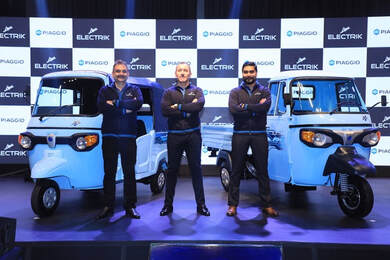The Ape’ Electrik FX range of electric vehicles are launched in the Cargo and Passenger segment. The new Ape’ E-Xtra FX is the most powerful electric cargo in the segment with 9.5 Kw power output. It comes with a proven full metal body architecture fitted with a useful 6 ft cargo deck length. It is also customizable for applications like the delivery van, garbage collector etc.
The passenger vehicle, Ape’ E-City FX is the most profitable 3 wheeler. Its superior features and comfortable ride ensures higher number of trips and best in class earnings.
Both the products come equipped with top of the range features like blue vision headlamps, automatic transmission, hill hold assist, regenerative braking, dual tone seats, striking body colours and graphics, multi- information instrument cluster, boost mode etc. The FX fixed battery range offers convenient home and office charging features.
“We are launching the FX range after a detailed study covering the industry trends, customer aspirations and segment requirements. The FX range will cater to the needs of our customers, protect the environment and truly revolutionize the industry with the concept of “Ape goes Electric, India goes Electric”-Mr. Saju Nair, EVP and Head of Commercial Vehicle Business, Piaggio India Pvt Ltd.
Both the products come equipped with top of the range features like blue vision headlamps, automatic transmission, hill hold assist, regenerative braking, dual tone seats, striking body colours and graphics, multi- information instrument cluster, boost mode etc. The FX fixed battery range offers convenient home and office charging features.
“We are launching the FX range after a detailed study covering the industry trends, customer aspirations and segment requirements. The FX range will cater to the needs of our customers, protect the environment and truly revolutionize the industry with the concept of “Ape goes Electric, India goes Electric”-Mr. Saju Nair, EVP and Head of Commercial Vehicle Business, Piaggio India Pvt Ltd.
PluginIndia's Take
The first version of Ape was in partnership with Sun Mobility and battery swapping. The next two vehicles come with fixed batteries. Maybe the customer acceptance for swapping will take time. So what Piaggio has done is beefed up battery capacity - 7.5 kWh for the passenger, and 8 kWh for the goods one. (Strange why have two battery packs with such a close range - one gets a feeling that they have kept reduced reserves for the cargo - but the battery is the same.) The motors are different though. 9.5 kW for cargo and 5.4 kW for the passenger one. So expect the cargo to have a lower range.
Incidentally, the company website makes no mention of range. Users have to come up with their own guesstimates, based on terrain and loads combinations. In the passenger swap battery vehicle the company has committed to a 68 km range with a 4.5 kWh battery. The assumption is about 66 wh/km, which is comparable to what the e2o gets when driven with a light foot. So with a 7.5 kWh battery, the fixed battery passenger vehicle should give a range of 100 km+, which is Ok for most urban drives. May require a boost around lunch time. The goods vehicle will definitely have range anxiety issues. Another problem for rural usage is going to be top speed. At 45 kmph, they will be too slow. These vehicles should work best in cities of North India, where there are not too many hill sections.
The first version of Ape was in partnership with Sun Mobility and battery swapping. The next two vehicles come with fixed batteries. Maybe the customer acceptance for swapping will take time. So what Piaggio has done is beefed up battery capacity - 7.5 kWh for the passenger, and 8 kWh for the goods one. (Strange why have two battery packs with such a close range - one gets a feeling that they have kept reduced reserves for the cargo - but the battery is the same.) The motors are different though. 9.5 kW for cargo and 5.4 kW for the passenger one. So expect the cargo to have a lower range.
Incidentally, the company website makes no mention of range. Users have to come up with their own guesstimates, based on terrain and loads combinations. In the passenger swap battery vehicle the company has committed to a 68 km range with a 4.5 kWh battery. The assumption is about 66 wh/km, which is comparable to what the e2o gets when driven with a light foot. So with a 7.5 kWh battery, the fixed battery passenger vehicle should give a range of 100 km+, which is Ok for most urban drives. May require a boost around lunch time. The goods vehicle will definitely have range anxiety issues. Another problem for rural usage is going to be top speed. At 45 kmph, they will be too slow. These vehicles should work best in cities of North India, where there are not too many hill sections.
Subscribe to PluginIndia on YouTube to follow the Indian EV Industry and EV Community. Also subscribe to our podcast.


